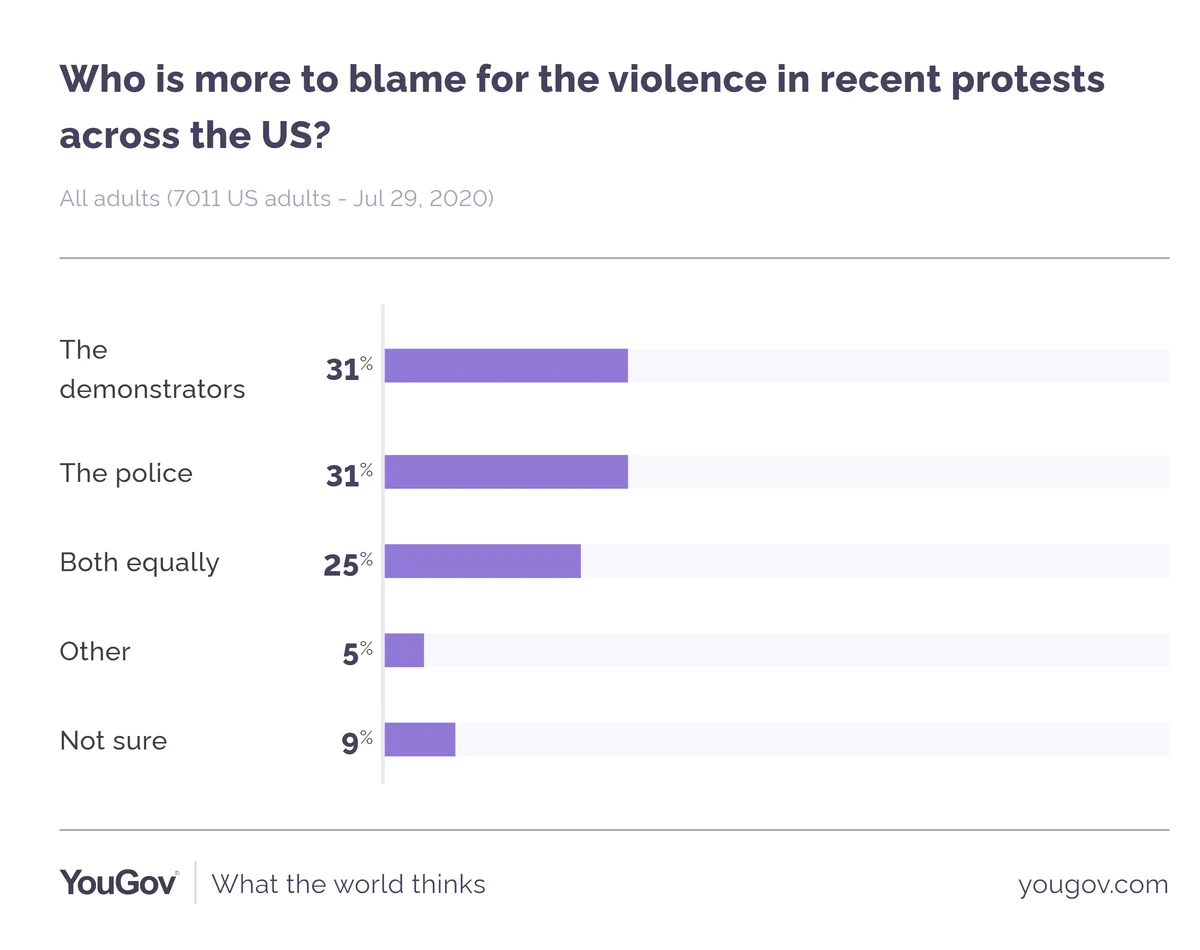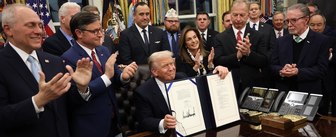When it comes to assigning responsibility for the violence at recent protests against police brutality, Americans are divided.
According to a recent YouGov Daily survey, 31 percent of Americans think the demonstrators are responsible for the violence at protests in cities like Portland and Kenosha, and 31 percent say it’s the police.

But what do YouGov users have to say about that violence? We asked our Chat users to go deeper on the issue and tell us their thoughts. You can share your views on the violence here.
“They showed up in Portland, in riot gear with tear gas, when protests were peaceful. They were looking for a fight”
When we asked Chat users to tell us why they said the police are responsible, most cited what they believe to be an excessive use of force and intimidation by police departments at protests. “Crowd control does not require full military armor. Nor should it use tear gas or rubber bullets,” reasoned one user. “Showing up to peaceful protests in full riot gear is an escalation of force, pepper spraying people as they walk by is an escalation of force, shooting people standing on their own property or public property is an escalation of force” wrote another.
These users frequently made the case that most protests since the killing of George Floyd have been non-violent, something they believe the police are unwilling or even unable to acknowledge. “I have been to peaceful protests that only turn violent once police show up with military gear and weapons and turn a march into a dangerous situation” wrote one user. Another said, “they could have left the protesters to March peacefully, instead they came out with batons and tear gas and rubber bullets, injuring people who only wanted to exercise their First Amendment rights.”
Of the 3,672 responses from users who believe police to be responsible for the violence, nearly one in five took issue with the “militarization” of the police force. Sentiments like “the police are militarized and displaying force that is disproportionate to the level of threat they are exposed to ” were reiterated by many.
A number of users put forward the argument that the reason why police are to blame for the violence is down to a lack of training. For example, one user wrote “they're untrained in de escalation and see every problem as one needing to be solved with a gun.” Another said, “they have not been trained to deal with non-violent protesters and are acting like they are in a war zone.”
Others saw it as a product of systematic racism (“Institutionalized racism and few consequences has led them to think they can do what they want.”) and the pervasion of white supremesists in the police force. (“Their [police’s] role in our system is to uphold a structural white supremacy with state-sanctioned violence”).
YouGov Chat also asks participants to consider the other side of the debate. Users that said the police are responsible for violence at recent protests said the most compelling reason to pin the blame on demonstrators was the argument “opportunists have infiltrated protests” (39%).
“The demonstrators are the only ones responsible for their actions. There are peaceful ways to get their points across.”
The idea that “opportunists have infiltrated protests” was certainly one of the main arguments put forward by Chat users who said the demonstrators were to blame for the violence at recent protests. “I think there is a subset that uses the protest to riot, cause chaos, force a response they can use to justify their anger” wrote one user. “The legitimate peaceful protests have been hijacked by violent terrorist groups” wrote another.
Others saw the violence in less divisive terms, choosing instead to delineate between a demonstrator and a looter: “Protesters are not to blame, but rioters that start vandalizing and looting are to blame..” reasoned one Chat user, “when they start “protesting” late at night and show their frustration by destroying cities the message they are trying to convey gets lost”.
Not every user was on board with such delineations though. Many argued that regardless of whether they had been “infiltrated”, the responsibility for the violence lay squarely on all demonstrators. “Everyone is accountable for their own actions” was a sentiment echoed by many users. “We have a choice. We control our actions. We will ultimately be responsible for what we do.”
Destruction of property appeared to be at the heart of most users' opinions. Comments like “they’re the ones that are destroying property and cities” appeared regularly when we asked Chat users to explain why they believe the demonstrators are to blame for the violence. “The police aren't forcing anyone to burn, deface, or otherwise destroy anything. Place the blame where it belongs.”
Some users took the opportunity to describe what they believe a protest should look like. “Peaceful protests are great! I did them in the 70s. But we never ever destroyed a thing, person or place” reasoned one user. Another called on demonstrators to “Get back to peaceful marches, boycotts, sit-ins, etc. --but quit the vandalism, theft, and injury to cops who are just doing their jobs (maintaining peace).”
“In all of the many videos I have seen, the protests are entirely peaceful”
Online videos have played a major role in shaping users' understanding of the protests. On both sides of the debate, participants were quick to cite a video they had seen as evidence for their views. “Every video I have seen the demonstrators start trying to destroy things before the police get physical.” wrote one user who said demonstrators were to blame for the violence. Similar arguments were made by users with opposing views: “I've seen video and analysis of the violence. It's clear that the police are out of control and turned many peaceful protests into riots.”
------------------------
Everyday, members of YouGov Chat are asked to share their opinion on a topic in the news. We allow anyone to take part in these chats, and do not display or weight results in real-time. Instead, to make the experience informative but still interactive, the Chat displays weighted data from YouGov Direct to show them how the rest of the country voted. This enables us to pose the question to all, while retaining data accuracy and validity when communicating results.
YouGov Chat seeks to add to the ‘what?’ (the quantitative poll result) by finding the ‘why?” (qualitative open ends) in a member’s own words. Learn more about YouGov Chat here.







